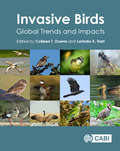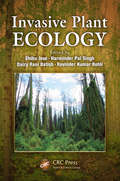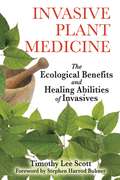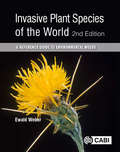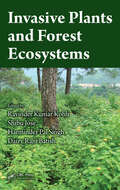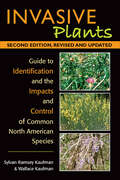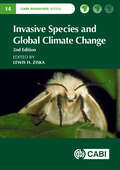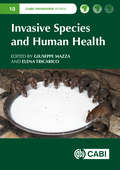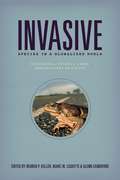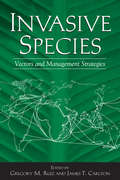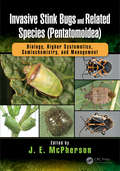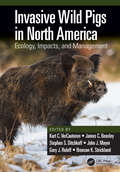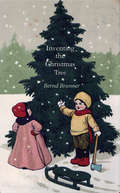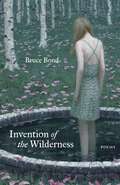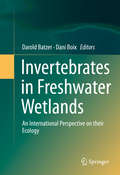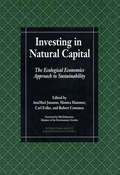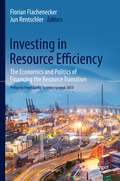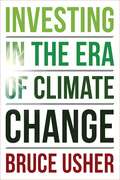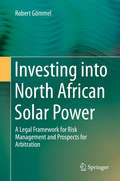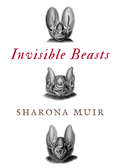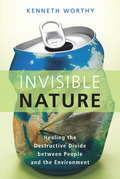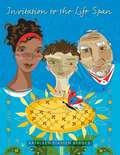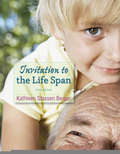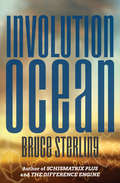- Table View
- List View
Invasive Birds: Global Trends and Impacts
by Matthew Burnett Bill Pranty Diederik Strubbe Erik Matthysen Matthieu Guillemain Johan Elmberg Iain Henderson Ding Li Yong Juan Carlos Reboreda Alexander Cruz Tim Adriaens Craig R Allen Michael L Avery Alexander V Badyaev Fabrice M Brescia Sarah E Britton Daniel M Brooks Jessica L. Burnett Corey T Callaghan César Capinha Jen Cele Jameson F Chace Jocelyn Champagnon Alice Cibois Andrew Close Alyssa R Conn Richard T Corlett Adrian J Craig Amy E Dunham James A Eaton David A Smith Yvette C Smith Mike W Eichholz Cyril Eraud Chris L Feare Jason M Gleditsch Guillaume G Gayet Carlos Gutiérrez-Expósito Haley E Hanson Frank Huysentruyt John G Innes Salit Kark Michael R Leven Ricardo J Lopes Jean-Francois Maillard Ndivhuwo Maligana Chloe I Marcheli Lynn B Martin Blake A Mathys Myriam E Mermoz Jean-Yves Meyer Dai K Morgan Katherine G Ohman Claire Pernollet Murray A Potter Eileen C Rees Luís Reino Joana Ribeiro Peter A Robertson Andrew M Rogers Philip D Round Joana Santana Cavin T Shivambu Neftalí Sillero Preshnee Singh Pär Söderquist Karina L Speziale Martin J Sullivan Jean-Claude Thibault Martin Thibault Berndt J van Rensburg Eric Vidal Joseph R Waas Amy-Leigh Wilson Katherine Winston Kevin A Wood Pierre Yésou Jaime E ZolikExamining globally invasive alien birds, the first part of this book provides an account of 32 global avian invasive species (as listed by the Invasive Species Specialist Group, ISSG). It acts as a one stop reference volume; it assesses current invasive status for each bird species, including details of physical description, diet, introduction and invasion pathways, breeding behaviour, natural habitat. It also looks at the environmental impact of each species, as well as current and future control methods. Full colour photographs assist with species identification and global distribution maps give a visual representation of the current known distributions of these species. The second part of the book discusses the biogeographical aspects of avian invasions, highlighting current and emerging invasive species across different regions of the world. The third section considers the impact of invasive species on native communities, problems associated with invasive bird management and the use of citizen science in the study of invasive birds.
Invasive Plant Ecology
by Shibu Jose Ravinder Kumar Kohli Harminder Pal Singh Daizy Rani BatishInvasion of non-native plant species, which has a significant impact on the earth's ecosystems, has greatly increased in recent years due to expanding trade and transport among different countries. Understanding the ecological principles underlying the invasive process as well as the characteristics of the invasive plants is crucial for making good
Invasive Plant Medicine: The Ecological Benefits and Healing Abilities of Invasives
by Stephen Harrod Buhner Timothy Lee ScottThe first book to demonstrate how plants originally considered harmful to the environment actually restore Earth’s ecosystems and possess powerful healing properties • Explains how invasive plants enhance biodiversity, purify ecosystems, and revitalize the land • Provides a detailed look at the healing properties of 25 of the most common invasive plants Most of the invasive plant species under attack for disruption of local ecosystems in the United States are from Asia, where they play an important role in traditional healing. In opposition to the loud chorus of those clamoring for the eradication of all these plants that, to the casual observer, appear to be a threat to native flora, Timothy Scott shows how these opportunistic plants are restoring health to Earth’s ecosystems. Far less a threat to the environment than the cocktails of toxic pesticides used to control them, these invasive plants perform an essential ecological function that serves to heal both the land on which they grow and the human beings who live upon it. These plants remove toxic residues in the soil, providing detoxification properties that can help heal individuals. Invasive Plant Medicine demonstrates how these “invasives” restore natural balance and biodiversity to the environment and examines the powerful healing properties offered by 25 of the most common invasive plants growing in North America and Europe. Each plant examined includes a detailed description of its physiological actions and uses in traditional healing practices; tips on harvesting, preparation, and dosage; contraindications; and any possible side effects. This is the first book to explore invasive plants not only for their profound medical benefits but also with a deep ecological perspective that reveals how plant intelligence allows them to flourish wherever they grow.
Invasive Plant Species of the World 2nd Edition
by Ewald WeberSince the publication of the first edition of this book in 2003, the status of many important invasive plants around the world has changed dramatically. Species have extended their ranges, new literature has been accumulated, and control methods have been improved. Research on some plant invaders has also focused on the species' ecology and impacts, confirming that invasive plants continue to pose serious threats to species and ecosystems. Given their range expansions and introduction via international trade, these problems will only become more serious in the future. Providing the latest information on the most important invasive plants, this new edition: - Contains 50 new species, chosen for their impacts on ecosystems and native species - Reviews the most significant new publications on ecology and species management - Updates introduced, invasive and native ranges, providing an easy-reference, full-colour map for each species - Provides new and improved control methods Including colour images of each species, this up-to-date reference guide on the most important plant invaders is an invaluable tool for both researchers and policy makers.
Invasive Plants and Forest Ecosystems
by Shibu Jose Ravinder Kumar Kohli Harminder Pal Singh Daizy Rani BatishAs the worldwide human population explodes and trade becomes increasingly globalized, the transboundary movement of plant species from their place of origin to foreign regions is escalating and expected to experience continued growth in the coming decades. Invasive non-native species pose one of the greatest challenges for natural resource managers who are charged with the maintenance of biological diversity and the sustainable production of forest resources. With international contributors presenting an informed and integrated approach to the control of havoc-wrecking species, Invasive Plants and Forest Ecosystems provides the most updated information on invading plants, their impacts on forest ecosystems, and control strategies. This text addresses such important issues as the socioeconomic and policy aspects of plant invasion and offers complete coverage of their ecological impacts and the varied levels of threats in diverse situations.
Invasive Plants: Guide to Identification and the Impacts and Control of Common North American Species
by Wallace Kaufman Sylvan Ramsey KaufmanNewly updated: &“Invasive plants are ecological tumors that degrade food webs wherever they go. The third edition of [this book] is an invaluable reference.&” —Douglas Tallamy, New York Times–bestselling author of Nature&’s Best Hope This easy-to-use, wide-ranging guide to invasive plants in North America features full-color photos and descriptions of more than 250 alien species—both terrestrial and aquatic—that are in some cases changing the landscape to an almost unimaginable degree. Accompanying text describes the plant&’s environmental and economic impacts as well as management techniques used to control it. Also included is an explanation of what an invasive is and a step-by-step identification key. Used by U.S. Forest Service botanists, this is an essential guide to understanding this unprecedented environmental challenge that is threatening biodiversity—and the human population that depends on it to survive. &“A colorful, general field guide to the major invasive plants of North America…packed with relevant information.&” —Great Plains Research: A Journal of Natural and Social Sciences &“A wonderful guide.&” —The Roanoke Star
Invasive Species and Global Climate Change (CABI Invasives Series)
by Lewis H. ZiskaThis book addresses topics related to the impact of invasive species including biosecurity, demographics, species diversity and food security. It is meant for researchers, upper-level students, and policy makers and provides a factual basis for the underlying science and a discussion of that information with respect to current and future impacts and possible solutions. This book explores the nexus of climate change and biological invasions, resulting impacts (biological and economic) and assesses ways to reduce vulnerability and increase the resiliency and sustainability of managed and unmanaged ecosystems. The book has three parts, focusing on: (1) the dimensions of the problem; background and science; (2) case studies; (3) Management: detection, prevention, control and adaptation. This revised edition examines a wide range of topics and region, the underlying science, examples (case studies) from around the world, and ways and means to recognize, manage and control the consequences. It includes new cases and new threats; for example, a chapter summarizing case studies regarding climate change and invasive species that are also disease carriers (e.g. ticks and Lyme disease). - Covers a wide range of topics and areas - Examines the synergy between invasive species and climate change - Explains options to control and mitigate effects This book is of interest to academics, researchers and students studying climate change and invasive species. Those interested in the environment and ecology, land managers, policy makers, agronomists, federal and state departments of natural resources, climate change activists, public health professionals.
Invasive Species and Human Health (CABI Invasives Series)
by Catherine Souty-Grosset Julian Reynolds Elena Tricarico Petr Pyšek Piero Genovesi Wolfgang Nentwig Alain Roques Giuseppe Mazza Pedro M. Anastácio Leonardo Ancillotto Sylvie Augustin Daniela Boccolini Giuseppe Brundu Dario Capizzi Lucilla Carnevali Marco Di Luca Franz Essl Bella Galil Giulio Grandi Lorenzo Lazzaro Antonella Lugliè Angeliki F. Martinou Jolyon M. Medlock Mattia Menchetti Andrea Monaco Emiliano Mori Nikola Pantchev Bachisio Mario Padedda Olivier S.G. Pauwels Cristina Preda Wolfgang Rabitsch Roberto Romi Helen E. Roy Marie-Anne Auger-Rozenberg Riccardo Scalera Francis Schaffner Stefan Schindler Francesco Severini Sauro Simoni Paolo Sposimo Diederik Strubbe Luciano TomaInvasive alien plants and animals are known for their disruption of ecosystems and threat to biodiversity. This book highlights their major impact on human health. This includes not only direct effects through contact with the species via bites, wounds and disease, but also indirect effects caused by changes induced in ecosystems by invasive species, such as more water hyacinth increasing mosquito levels and thereby the potential for malaria. Covering a wide range of case studies from different taxa (animals and plants), and giving an overview of the diverse impacts of invasive species on health in developed and developing countries, the book is a significant contribution that will help in prioritizing approaches to controlling invasive species and mitigating their health effects. It covers invasive plants, marine species, spiders and other arachnids, ticks and dust mites, insects, mosquitos and other diptera, freshwater species (invertebrates and fishes), amphibians and reptiles, birds and mammals. Key Features Collects together the major health impacts for the first time Covers animal and plant invasive species Examines issues in developed and developing countries The broad spectrum of the analyzed case studies will ensure the appeal of the book to a wide public, including researchers of biological invasions, doctors, policy-makers and managers, and students of invasive species in ecology, animal and plant biology and public health medicine.
Invasive Species and Human Health (Plant Science / Horticulture Ser. #10)
by Catherine Souty-Grosset Julian Reynolds Petr Pyšek Piero Genovesi Wolfgang Nentwig Alain Roques Pedro M. Anastácio Leonardo Ancillotto Sylvie Augustin Daniela Boccolini Giuseppe Brundu Dario Capizzi Lucilla Carnevali Marco Di Luca Franz Essl Bella Galil Giulio Grandi Lorenzo Lazzaro Antonella Lugliè Angeliki F. Martinou Jolyon M. Medlock Mattia Menchetti Andrea Monaco Emiliano Mori Nikola Pantchev Bachisio Mario Padedda Olivier S.G. Pauwels Cristina Preda Wolfgang Rabitsch Roberto Romi Helen E. Roy Marie-Anne Auger-Rozenberg Riccardo Scalera Francis Schaffner Stefan Schindler Francesco Severini Sauro Simoni Paolo Sposimo Diederik Strubbe Luciano TomaInvasive alien plants and animals are known for their disruption of ecosystems and threat to biodiversity. This book highlights their major impact on human health. This includes not only direct effects through contact with the species via bites, wounds and disease, but also indirect effects caused by changes induced in ecosystems by invasive species, such as more water hyacinth increasing mosquito levels and thereby the potential for malaria. Covering a wide range of case studies from different taxa (animals and plants), and giving an overview of the diverse impacts of invasive species on health in developed and developing countries, the book is a significant contribution that will help in prioritizing approaches to controlling invasive species and mitigating their health effects. It covers invasive plants, marine species, spiders and other arachnids, ticks and dust mites, insects, mosquitos and other diptera, freshwater species (invertebrates and fishes), amphibians and reptiles, birds and mammals. Key Features Collects together the major health impacts for the first time Covers animal and plant invasive species Examines issues in developed and developing countries The broad spectrum of the analyzed case studies will ensure the appeal of the book to a wide public, including researchers of biological invasions, doctors, policy-makers and managers, and students of invasive species in ecology, animal and plant biology and public health medicine.
Invasive Species in a Globalized World: Ecological, Social, & Legal Perspectives on Policy
by Reuben P. Keller, Marc W. Cadotte, Glenn SandifordOver the past several decades, the field of invasion biology has rapidly expanded as global trade and the spread of human populations have increasingly carried animal and plant species across natural barriers that have kept them ecologically separated for millions of years. Because some of these nonnative species thrive in their new homes and harm environments, economies, and human health, the prevention and management of invasive species has become a major policy goal from local to international levels. Yet even though ecological research has led to public conversation and policy recommendations, those recommendations have frequently been ignored, and the efforts to counter invasive species have been largely unsuccessful. Recognizing the need to engage experts across the life, social, and legal sciences as well as the humanities, the editors of this volume have drawn together a wide variety of ecologists, historians, economists, legal scholars, policy makers, and communications scholars, to facilitate a dialogue among these disciplines and understand fully the invasive species phenomenon. Aided by case studies of well-known invasives such as the cane toad of Australia and the emerald ash borer, Asian carp, and sea lampreys that threaten US ecosystems, Invasive Species in a Globalized World offers strategies for developing and implementing anti-invasive policies designed to stop their introduction and spread, and to limit their effects.
Invasive Species: Vectors and Management Strategies
by Gregory M. Ruiz James CarltonInvasive Species brings together in a single volume new information from leading scientists around the world on approaches to controlling and managing invasion vectors. This volume is a timely and essential reference for scientists, researchers, policymakers, and anyone concerned with understanding biological invasions and developing effective responses to them.
Invasive Stink Bugs and Related Species: Biology, Higher Systematics, Semiochemistry, and Management (Contemporary Topics in Entomology)
by J. E. McPhersonKey features: Presents a brief history of past classifications, a summary of present classification, and speculation on how the classification may evolve in the future Includes keys for the identification of families and subfamilies of the Pentatomoidea and for the tribes in the Pentatomidae Explains transmission of plant pathogens and concepts of pathology and heteropteran feeding for the non-specialist Provides an extensive literature review of transmission by stink bugs of viral, bacterial, fungal, and protozoan organisms that cause diseases of plants Discusses the diversity of microbial symbionts in the Pentatomidae and related species, showing how microorganisms underpin the evolution of this insect group Reviews semiochemicals (pheromones, kairomones, allomones) of the Pentatomoidea and their vital role in the life histories of pest and beneficial species and their exploitation by natural enemies of true bugs Covers past, current, and future control options for insects, with a focus on stink bugs and related heteropterans The Superfamily Pentatomoidea (stink bugs and their relatives) is comprised of 18 families with over 8,000 species, the largest of which is the family Pentatomidae (about 5,000 species). These species primarily are phytophagous, and many cause tremendous economic damage to crops worldwide. Within this superfamily are six invasive species, two that occur worldwide and four that are recent invaders in North America. Once established in new geographic regions, these species have increased their numbers and geographic distributions dramatically, causing economic damage totaling billions of dollars. Invasive Stink Bugs and Related Species (Pentatomoidea): Biology, Higher Systematics, Semiochemistry, and Management is the first book that presents comprehensive coverage of the biology of invasive pentatomoids and related true bug species and addresses issues of rapidly growing economic and environmental concerns. Containing the contributions of more than 60 stink bug specialists from 15 countries, this book provides a better understanding of the biology and economic importance of these invasive species, why they became invasive, and how their continued geographical expansion is likely to affect numerous agricultural systems and natural environments. Including over 3,500 references, this authoritative work serves as an access point to the primary literature on their life histories, higher systematics, diapause and seasonal cycles, pathogens, symbionts, semiochemistry, and pest management control strategies for pentatomoid bugs.
Invasive Wild Pigs in North America: Ecology, Impacts, and Management
by Kurt C. VerCauteren James C. Beasley Stephen S. Ditchkoff John J. Mayer Gary J. Roloff Bronson K. StricklandThroughout North America, non-native wild pigs have become an ecologically and economically destructive invasive species. Though they are regarded as a popular game species by some, provide economic benefits to others, and are even engrained into societal heritage in some areas, wild pigs are responsible for an extraordinary amount of damage in both natural and anthropogenic systems throughout North America. As the density and range of wild pig habitat have substantially increased over the last several decades, the magnitude and diversity of their negative impacts are not yet fully realized or quantified. With various conflicts continually emerging, wild pig management is difficult and expensive to achieve. As a result, wild pigs represent one of the greatest wildlife management challenges North America faces in the 21st century. Invasive Wild Pigs in North America: Ecology, Impacts, and Management addresses all aspects of wild pig biology, ecology, damage, and management in a single comprehensive volume. It assimilates and organizes information on the most destructive introduced vertebrate species in the United States, establishing a foundation from which managers, researchers, policy makers, and other stakeholders can build upon into the future. The book provides comprehensive coverage of wild pig biology and ecology, techniques for management and research, and regional chapters. It is an asset to readers interested in wild pigs, the resources they impact, and how to mitigate those impacts, and establishes a vision of the future of wild pigs in North America. Features: Compiles valuable knowledge for a broad audience including wild pig managers, researchers, adversaries, and enthusiasts from across North America Addresses taxonomy, morphology, genetics, physiology, spatial ecology, population dynamics, diseases and parasites, and the naturalized niche of wild pigs Includes chapters on damage to resources, management, research methods, human dimensions and education, and policy and legislation Contains full color images and case studies of interesting and informative situations being created by wild pigs throughout North America Includes a chapter on wild pigs at the wildland–urban interface, a more recent and especially challenging issue
Inventing the Christmas Tree
by Bernd Brunner Benjamin A. SmithA colorfully decorated Christmas tree, lit with twinkling lights, provokes awe and delight. We understand the lighted tree as a central symbol of the Christmas season, but what are the roots of the tradition? Who first thought to bedeck a tree, to bring it inside? How and where did the local activity grow into a widespread tradition, and how has the Christmas tree traveled across time and continents? Bernd Brunner's brief history--enriched by a selection of delightful and unusual historical illustrations--spans many centuries and cultures to illuminate the mysteries of the Christmas tree and its enduring hold on the human imagination. Tracing various European traditions from the Middle Ages forward, Brunner finds that only in the nineteenth century did Christmas trees become common in European family homes. In North America, the imported custom soon fascinated, though some found the tree not quite compatible with a Puritan mindset. Brunner explores how the Christmas tree entered mainstream American culture and how in recent times it has become globally popular. He introduces Jacqueline Kennedy's Nutcracker Tree in the White House, trees used to celebrate the New Year in Turkey, and the world's most expensive Christmas tree, erected in Abu Dhabi. The author also considers the place of the artificial tree and the ecological dimensions of the Christmas tree trade. A book rich with anecdote and insight, Inventing the Christmas Tree will enchant a wide audience.
Invention of the Wilderness: Poems
by Bruce BondIn Invention of the Wilderness, Bruce Bond explores the wilderness as a spiritual, psychological, and ecological realm—a territory that, depending on our tolerances and affections, calls out for order, exploitation, expansion, or preservation. Although to talk of “inventing” the wilderness seems paradoxical, the book seeks to reclaim the etymological root of “invention” as a “venturing in.” To invent a wilderness is to go inward by way of attentive engagement in the natural world, to affirm and liberate imaginative expression as no mere mirror of nature, but a force of it. At times meditative and melancholic, though also vibrant and full of life, Invention of the Wilderness proposes an embodied and reflective way of being in the world.
Invertebrates in Freshwater Wetlands
by Darold Batzer Dani BoixWetlands are among the world's most valuable and most threatened habitats, and in these crucially important ecosystems, the invertebrate fauna holds a focal position. Most of the biological diversity in wetlands is found within resident invertebrate assemblages, and those invertebrates are the primary trophic link between lower plants and higher vertebrates (e. g. amphibians, fish, and birds). As such, most scientists, managers, consultants, and students who work in the world's wetlands should become better informed about the invertebrate components in their habitats of interest. Our book serves to fill this need by assembling the world's most prominent ecologists working on freshwater wetland invertebrates, and having them provide authoritative perspectives on each the world's most important freshwater wetland types. The initial chapter of the book provides a primer on freshwater wetland invertebrates, including how they are uniquely adapted for life in wetland environments and how they contribute to important ecological functions in wetland ecosystems. The next 15 chapters deal with invertebrates in the major wetlands across the globe (rock pools, alpine ponds, temperate temporary ponds, Mediterranean temporary ponds, turloughs, peatlands, permanent marshes, Great Lakes marshes, Everglades, springs, beaver ponds, temperate floodplains, neotropical floodplains, created wetlands, waterfowl marshes), each chapter written by groups of prominent scientists intimately knowledgeable about the individualwetland types. Each chapter reviews the relevant literature, provides asynthesis of the most important ecological controls on the residentinvertebrate fauna, and highlights important conservation concerns. The finalchapter synthesizes the 15 habitat-based chapters, providing a macroscopicperspective on natural variation of invertebrate assemblage structure acrossthe world's wetlands and a paradigm for understanding how global variation andenvironmental factors shape wetland invertebrate communities.
Investing in Natural Capital: The Ecological Economics Approach To Sustainability (Intl Society for Ecological Economics)
by Carl Folke Robert Costanza Monica Hammer Annmari JanssonInvesting in Natural Capital presents the results of a workshop held following the second biannual conference of the International Society for Ecological Economics. It focuses on the relation of human development to natural capital, and the relation of natural capital to environmental processes.Because we are capable of understanding our impact on the environment and the importance of managing it sustainably, humans play a special role in our ecosystem. The book emphasizes the essential connections between natural ecosystems and human socioeconomic systems, and the importance of insuring that both remain resilient. Specific chapters deal with methodology, case material, and policy questions, and offer a thorough exploration of this provocative and important alternative to conventional economics.
Investing in Resource Efficiency: The Economics and Politics of Financing the Resource Transition
by Florian Flachenecker Jun RentschlerThis book covers the multi-faceted incentives, trade-offs, and challenges associated with the economics and politics of resource efficiency investments. By contributing a wide range of empirical evidence, practitioners' insights, and policy perspectives, this book carefully examines the role of resource efficiency in reconciling environmental and economic considerations. It also discusses the critical role of resource efficiency investments in mitigating climate change and enabling sustainable development. Featuring expert insights from academia, the European Commission, the European Investment Bank, and the European Bank for Reconstruction and Development, this book provides a policy oriented guide, reference, and toolbox for unlocking the potential of resource efficiency. To this end, it identifies practical measures for overcoming barriers and creating smart incentives for leveraging resource efficiency investments. Overall, this book brings together evidence to develop innovative ideas and strategies for improving the efficient use of resources and advancing clean and sustainable development."This book is an important and timely contribution", Angel Gurria, Secretary General, OECD
Investing in the Era of Climate Change
by Professor Bruce UsherA climate catastrophe can be avoided, but only with a rapid and sustained investment in companies and projects that reduce greenhouse gas emissions. To the surprise of many, this has already begun. Investors are abandoning fossil-fuel companies and other polluting industries and financing businesses offering climate solutions. Rising risks, evolving social norms, government policies, and technological innovation are all accelerating this movement of capital.Bruce Usher offers an indispensable guide to the risks and opportunities for investors as the world faces climate change. He explores the role that investment plays in reducing emissions to net zero by 2050, detailing how to finance the winners and avoid the losers in a transforming global economy. Usher argues that careful examination of climate solutions will offer investors a new and necessary lens on the future for their own financial benefit and for the greater good. Companies that reduce greenhouse gas emissions will create great wealth, and, more importantly, they will provide a lifeline for humanity.Grounded in academic and industry research, Usher’s insights bring clarity to a complex and controversial topic while illuminating the people behind the numbers. This book sets out a practical and actionable plan for investors that will alter the course of climate change.
Investing into North African Solar Power
by Robert GömmelThis book investigates how a North African solar thermal power plant can be set up under the guidance of European investors (e. g. the Desertec Concept) as a Public Private Partnership (PPP). It outlines the importance of early awareness of contract-related risks, investment risks and dispute settlement, arguing that commercial and investment arbitration are the best tools for settling disputes regarding a large-scale solar thermal project. Furthermore, by comparing institutional and ad hoc arbitration, it shows that the former offers highly suitable support. The latest developments in the area of investment arbitration under EU law and the general acceptance of arbitration in Islamic countries are examined in particular. This book also demonstrates that a solar thermal power plant must meet certain requirements to be considered an investment. These requirements are examined in relation to Art. 25 of the International Centre for Settlement of Investment Disputes Convention (ICSID Convention) and respective case law. Overall, the book offers valuable guidelines for investors and host states on how to successfully implement large-scale solar thermal projects.
Invisible Beasts
by Sharona Muir"An amazing feat of imagination." -Publishers Weekly (starred review)"Invisible Beasts is a strange and beautiful meditation on love and seeing, a hybrid of fantasy and field guide, novel and essay, treatise and fable. With one hand it offers a sad commentary on environmental degradation, while with the other it presents a bright, whimsical, and funny exploration of what it means to be human. It's wonderfully written, crazily imagined, and absolutely original." -ANTHONY DOERR, author of All the Light We Cannot See and The Shell CollectorSophie is an amateur naturalist with a rare genetic gift: the ability to see a marvelous kingdom of invisible, sentient creatures that share a vital relationship with humankind. To record her observations, Sophie creates a personal bestiary and, as she relates the strange abilities of these endangered beings, her tales become extraordinary meditations on love, sex, evolution, extinction, truth, and self-knowledge.In the tradition of E.O. Wilson's Anthill, Invisible Beasts is inspiring, philosophical, and richly detailed fiction grounded by scientific fact and a profound insight into nature. The fantastic creations within its pages-an ancient animal that uses natural cold fusion for energy, a species of vampire bat that can hear when their human host is lying, a continent-sized sponge living under the ice of Antarctica-illuminate the role that all living creatures play in the environment and remind us of what we stand to lose if we fail to recognize our entwined destinies.Sharona Muir is the author of The Book of Telling: Tracing the Secrets of My Father's Lives. The recipient of a Hodder Fellowship and National Endowment for the Arts Fellowship, her writing has appeared in Granta, Orion magazine, Virginia Quarterly Review, The Paris Review, and elsewhere. She is a Professor of Creative Writing and English at Bowling Green State University. Invisible Beasts is her first novel.
Invisible Nature
by Kenneth WorthyA revolutionary new understanding of the precarious modern human-nature relationship and a path to a healthier, more sustainable world.Amidst all the wondrous luxuries of the modern world--smartphones, fast intercontinental travel, Internet movies, fully stocked refrigerators--lies an unnerving fact that may be even more disturbing than all the environmental and social costs of our lifestyles. The fragmentations of our modern lives, our disconnections from nature and from the consequences of our actions, make it difficult to follow our own values and ethics, so we can no longer be truly ethical beings. When we buy a computer or a hamburger, our impacts ripple across the globe, and, dissociated from them, we can't quite respond. Our personal and professional choices result in damages ranging from radioactive landscapes to disappearing rainforests, but we can't quite see how. Environmental scholar Kenneth Worthy traces the broken pathways between consumers and clean-room worker illnesses, superfund sites in Silicon Valley, and massively contaminated landscapes in rural Asian villages. His groundbreaking, psychologically based explanation confirms that our disconnections make us more destructive and that we must bear witness to nature and our consequences. Invisible Nature shows the way forward: how we can create more involvement in our own food production, more education about how goods are produced and waste is disposed, more direct and deliberative democracy, and greater contact with the nature that sustains us.
Invitation to the Life Span
by Kathleen Stassen BergerThis brief, original, 15-chapter textbook was created from page 1 to address the challenges teachers and students face when covering the entire life span in a semester (or even a quarter!). The hallmark Berger qualities are all here--the relatable presentation of research, the inclusive approach to world cultures, the study help that builds critical thinking and observational skills, the outstanding media and supplements--and all held together with Berger's skill in bringing students and the science together.
Invitation to the Life Span
by Kathleen Stassen BergerEdition after edition, Kathleen Stassen Berger's bestselling textbooks connect all kinds of students to current state of developmental psychology, in an engaging, accessible, culturally inclusive way. Berger'sInvitation to the Life Span does this in just 15 concise chapters, in a presentation that meets the challenges of exploring the breadth of the life span in a single term. The new edition of Invitation to the Life Span incorporates a wide range of new research, especially in fast-moving areas such as brain development and psychopathology, while taking advantage of innovative new tools for media-centered teaching and learning, including seamless integration with the book's dedicated version of Worth's online course space, LaunchPad. But throughout, as always, the signature voice of Kathleen Berger ties it all together, with relatable explanations of scientific content, wide ranging cultural examples, and skill-building tools for sharper observation and critical thinking.
Involution Ocean
by Bruce SterlingA far-future Moby-Dick by the author of Schismatrix: A desperate addict on a bleak, arid planet boards a whaling vessel to hunt the drug he craves. The powerful narcotic syncophine, commonly known as Flare, comes from only one source: the oil of the gargantuan whale-like beasts that swim the dust sea of Nullaqua. It was John Newhouse&’s addiction to the substance that made him a dealer and forced him to move to this airless, inhospitable planet But when the all-powerful galactic Confederacy declares Flare illegal, the needs of Newhouse and his clientele leave the desperate off-worlder no choice but to sign on as an able seaman aboard a dustwhaler and hunt the giant creatures himself. Joining a crew of junkies and misfits, including a mad captain with his own dark and secret agenda and a bewitching, batlike alien woman who is pained by human touch, Newhouse sets out across the silica ocean at the bottom of a seventy-mile-deep crater in search of release and redemption . . . and sails toward a fateful confrontation between man and beast that could lead to catastrophe. Bruce Sterling&’s debut novel is a remarkable feat of world building—imaginative, provocative, and smart, featuring an unforgettable cast of colorful characters. If Herman Melville&’s Moby-Dick unfolded on Frank Herbert&’s Dune, the result might be something akin to Sterling&’s extraordinary Involution Ocean.
